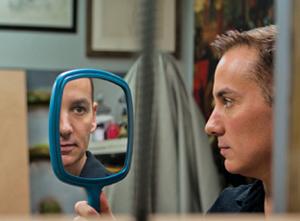Reviving Classicism
By Katherine Jamieson
 Graydon Parrish ′99
|
A woman approached Graydon Parrish after he gave a talk at the Connecticut museum that owns his painting The Cycle of Terror and Tragedy, September 11, 2001. She said the work was a favorite of her daughter, who’d died of cancer at the age of 16. Parrish has heard from other grieving relatives, too—often family members of firefighters. “It’s wrenching,” he says. “People reveal their lives and tragedies to me. I’m answering to those kinds of stories in a way I didn’t think I would as an artist.”
Parrish first made news in 1999, when a group of Amherst trustees purchased the painting that earned him summa honors, Remorse, Despondence, and the Acceptance of an Early Death. An allegory of the AIDS epidemic, it depicts three figures on a funerary barge, surrounding the corpse of a child; each figure personifies a stage of the grieving process. The oil painting now hangs in Frost Library.
At 18 feet by 7 feet, The Cycle of Terror and Tragedy is one of the largest realist oil paintings ever created in the United States. Commissioned by the New Britain Museum of American Art, where it has been on exhibit since 2006, it portrays two identical, blindfolded men, heads tipped skyward, screaming, hands contorted. Parrish spent four years on the piece.
Parrish’s work stands out for its revival of 19th-century classicism. He graduated with an M.F.A. from the New York Academy of Art seven years before earning his B.A. at Amherst, and although he admires abstract expressionism and other modern styles, he finds the realistic figure more effective for communicating emotion. “What appeals to us about painting,” he says, “is not the theory of why it is expressed. What people pick up on is evocation of humanity, the glow of humanity.”
For two years, he’s been working on a portrait of Carmen Dell’Orefice, an 80-year-old icon of the fashion world who’s been modeling since she was 13. Dell’Orefice, whose visage has been rendered by everyone from Dalí to Avedon, brought Parrish as her date to a New York City Fashion Week event this fall. Such interactions give him more insight into his models, allowing him to paint “both the inside and the outside,” he says. “I love the nuances, the light, the glint in the hair of my subjects. I’m very much a humanist; it informs everything I do.”
Photo by Rob Mattson